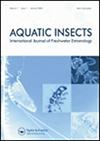Life history of Laccophilus dikinohaseus Kamite, Hikida, and Satô, 2005 (Coleoptera: Dytiscidae) and its preferences for oviposition substrates
IF 0.6
4区 农林科学
Q4 ENTOMOLOGY
引用次数: 0
Abstract
AbstractWe describe the life history of Laccophilus dikinohaseus Kamite, Hikida, and Satô, Citation2005 using laboratory rearing-based methods to contribute to future ex situ and in situ conservation. At 26 °C, each developmental stage had the following duration: egg, 6–7 days; first-instar, 3–5 days; second-instar, 3–5 days; third-instar in water, 7–18 days; landing to leaving the pupal chamber, 9–11 days; and total duration of the immature stages, 30–44 days. The total larval period was significantly longer than those of L. yoshitomii Watanabe and Kamite, Citation2018, L. kobensis Sharp, Citation1873, and L. hebusuensis Watanabe and Kamite, Citation2020. The maximum complete lifespan (egg to adult death) and adult lifespan (exiting the pupal chamber to adult death) were 792 and 762 days, respectively, indicating that L. dikinohaseus can live for more than two years after the adults exit the pupal chamber. Laccophilus dikinohaseus laid eggs not only in aquatic plants but also in driftwood and withered plants, suggesting a diverse oviposition substrate availability. This is the first study on the immature stages of L. dikinohaseus and lifespan of Laccophilus. We propose in situ conservation measures for L. dikinohaseus based on its findings.Keywords: Conservationdiving beetleegg laying behaviourimmature stagelifespan AcknowledgementsWe express our sincere gratitude to Tomoki Sumikawa at the Ishikawa Insect Museum for his cooperation with rearing experiments and confirming the ages of larvae. We would also like to thank Naoto Kokubun for his help in identifying the plants, Toshiki Takano and Daiki Uchida for their assistance in the survey, and Wataru Mukaimine and Futoshi Ujiie for their advice in the analysis. Finally, we would like to thank Editage (www.editage.jp) for English language editing.Disclosure statementThe authors declare no conflict of interest.Kamite, Hikida, and Satô, 2005(鞘翅目:蝶蛾科)乳酸菌生活史及其对产卵基质的偏好
摘要本文采用实验室饲养的方法对dikinohaseus Kamite, Hikida和Satô的生活史进行了描述,以期为今后的迁地和原位保护做出贡献。在26℃下,每个发育阶段的持续时间如下:卵,6-7天;1龄,3-5天;二龄,3-5天;水中3龄,7-18天;落地至离开蛹房,9-11天;未成熟阶段的总持续时间为30-44天。总幼虫期显著高于渡边利氏l (yoshitomii Watanabe)和Kamite (Citation2018)、kobensis Sharp (Citation1873)和渡边利氏l (hebusuensis Watanabe)和Kamite (Citation2020)。最大完整寿命(产卵至成虫死亡)和最大完整寿命(离开蛹室至成虫死亡)分别为792天和762天,表明成虫离开蛹室后可存活2年以上。dikinohaseus不仅在水生植物中产卵,而且在浮木和枯萎植物中产卵,表明其产卵基质的多样性。这是首次对乳酸菌的未成熟阶段和寿命进行研究。在此基础上,提出了dikinohaseus的原位保护措施。关键词:保护潜水甲虫产卵行为成熟阶段寿命感谢石川昆虫博物馆Tomoki Sumikawa在饲养实验和确定幼虫年龄方面的合作。我们还要感谢Naoto Kokubun在识别植物方面的帮助,Toshiki Takano和Daiki Uchida在调查中提供的帮助,Wataru Mukaimine和Futoshi Ujiie在分析中提供的建议。最后,我们要感谢意得辑(www.editage.jp)的英文编辑。声明作者声明无利益冲突。
本文章由计算机程序翻译,如有差异,请以英文原文为准。
求助全文
约1分钟内获得全文
求助全文
来源期刊

Aquatic Insects
生物-昆虫学
CiteScore
2.00
自引率
25.00%
发文量
27
审稿时长
>12 weeks
期刊介绍:
Aquatic Insects is an international journal publishing original research on the systematics, biology, and ecology of aquatic and semi-aquatic insects.
The subject of the research is aquatic and semi-aquatic insects, comprising taxa of four primary orders, the Ephemeroptera, Odonata, Plecoptera, and Trichoptera but also aquatic and semi-aquatic families of Hemiptera, Coleoptera, and Diptera, as well as specific representatives of Hymenoptera , Lepidoptera, Mecoptera, Megaloptera , and Neuroptera that occur in lotic and lentic habitats during part of their life cycle. Studies on other aquatic Hexapoda (i.e., Collembola) will be only accepted if space permits. Papers on other aquatic Arthropoda (e.g., Crustacea) will not be considered, except for those closely related to aquatic and semi-aquatic insects (e.g., water mites as insect parasites).
The topic of the research may include a wide range of biological fields. Taxonomic revisions and descriptions of individual species will be accepted especially if additional information is included on habitat preferences, species co-existing, behavior, phenology, collecting methods, etc., that are of general interest to an international readership. Descriptions based on single specimens are discouraged.
Detailed studies on morphology, physiology, behavior, and phenology of aquatic insects in all stadia of their life cycle are welcome as well as the papers with molecular and phylogenetic analyses, especially if they discuss evolutionary processes of the biological, ecological, and faunistic formation of the group.
 求助内容:
求助内容: 应助结果提醒方式:
应助结果提醒方式:


